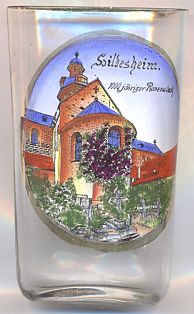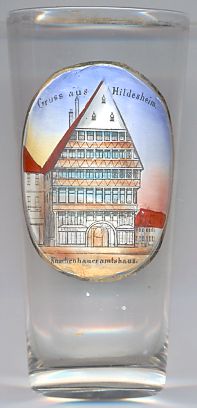

|
| DEUTSCHLAND | GERMANY |
| Bundesland: Niedersachsen | Lower Saxony |
| Landkreis: Hildesheim |
Hildesheim is situated at an elevation of 78 m at the river Innerste in the south of Germany's state of Niedersachsen. With a population of about 102,600 (2005) Hildesheim is the largest town of the Hildesheim district, of which it is also the seat of the district administration.
It is very likely that a settlement existed at this place already very early. However, the written mention of the place under the name 'Bennopolis', dated to AD 577, apparently is a forgery. It is certain, however, that Hildesheim in AD 815 became the seat of a bishopric. The cathedral was fortified around 1000 and the settlement next to the cathedral ('Altstadt', 'old town') soon became an important trading place. In the 12th and 13th centuries two further settlements, 'Dammstadt' ('dam town') and 'Neustadt' ('new town'), were founded. While Altstadt conquered Dammstadt in 1332, the walls between Altstadt and Neustadt were peacefully removed only in 1583. Nevertheless, Altstadt and Neustadt retained separate city councils until 1803. Although Hildesheim formally was part of the sovereign country of the Hildesheim bishops, the city already around 1300 obtained the status of a town with its own city rights. In 1367 Hildesheim joined the Hanseatic League. In the so-called 'Hildesheimer Stiftsfehde', the sovereign bishops lost large parts of their territory to the principality of Braunschweig-Wolfenbüttel and the principality of Calenberg (part of Braunschweig-Lüneburg and origin of the electorate, later kingdom, of Hannover). Although the Protestant faith was introduced in the town in 1542, the Catholic bishopric remained a sovereign state and the cathedral and monasteries remained Catholic.
The temporal rule of the bishops ended in 1803 when their territory, like all other ecclesiastical sovereign states, was secularized. The territory at first became part of Prussia, in 1807 it came under French rule until it was attached to the kingdom of Hannover in 1813. When the kingdom was annexed by Prussia in 1866, Hildesheim became Prussian again. In 1885 Hildesheim obtained the status of a city administered as a district in its own right and also became the seat of the administration of the (rural) district and of the administrative region of the same name. During World War II, about 90% of the town was destroyed. The historc city, once famous for its half-timebred houses was almost completely lost. After 1948 the town was rebuilt and some of its historic buildings were recontructed.

The  cathedral Sankt Maria [background] is the seat of the bishops of Hildesheim. The first cathedral church at this place was founded in 872.
This first church was enlarged between the 11th and 14th centuries. All following later church buildings were erected on these old foundations.
Famous treasures of the church are the bronze Bernward's Gate of 1015, the bronze Christ's Column of 1020, the Hezilo chandelier of the 11th century,
the late Romanesque baptismal font of 1225, the shrines of St. Epiphanius of Pavia and St. Godehard and many other valuable treasures.
In 1985 the cathedral was listed as a World Cultural Heritage by UNESCO (see also list of other UNESCO heritage sites).
cathedral Sankt Maria [background] is the seat of the bishops of Hildesheim. The first cathedral church at this place was founded in 872.
This first church was enlarged between the 11th and 14th centuries. All following later church buildings were erected on these old foundations.
Famous treasures of the church are the bronze Bernward's Gate of 1015, the bronze Christ's Column of 1020, the Hezilo chandelier of the 11th century,
the late Romanesque baptismal font of 1225, the shrines of St. Epiphanius of Pavia and St. Godehard and many other valuable treasures.
In 1985 the cathedral was listed as a World Cultural Heritage by UNESCO (see also list of other UNESCO heritage sites).
The  Hildesheim Millennial Rose Tree [centre] is located in the cloister of the cathedral, at the outside apse wall.
The age of the rose tree could not be determined exactly, a popular legend mentions the year 815. According to this legend,
Emperor Ludwig I ('the Pious') during a hunt ordered a mass to be celebrated at this location. A reliquiar of the virgin Mary was hung on the rosebush
but later miraculously could not be removed. This was said to be the reason that the bishopric was founded here and not, as had been planned before that,
at Elze. In modern times, the written sources continuously mention the rose tree for at least 400 years. When the cathedral was severely damaged by explosive and
incendiary bombs in 1945, the rose tree was buried underneath the rubble and only a charred stump remained. However, the roots remained intact and soon the rose tree
grew new branches. The rose tree immediately became the beloved symbol of the rebuilt town. The Hildesheim rose tree is estimated to be the world's oldest living rose.
Hildesheim Millennial Rose Tree [centre] is located in the cloister of the cathedral, at the outside apse wall.
The age of the rose tree could not be determined exactly, a popular legend mentions the year 815. According to this legend,
Emperor Ludwig I ('the Pious') during a hunt ordered a mass to be celebrated at this location. A reliquiar of the virgin Mary was hung on the rosebush
but later miraculously could not be removed. This was said to be the reason that the bishopric was founded here and not, as had been planned before that,
at Elze. In modern times, the written sources continuously mention the rose tree for at least 400 years. When the cathedral was severely damaged by explosive and
incendiary bombs in 1945, the rose tree was buried underneath the rubble and only a charred stump remained. However, the roots remained intact and soon the rose tree
grew new branches. The rose tree immediately became the beloved symbol of the rebuilt town. The Hildesheim rose tree is estimated to be the world's oldest living rose.

The  Knochenhaueramtshaus [left] in the Market Square is the best-known half-timbered house of Hildesheim.
It was built in 1529 as the butchers' guild hall. The ground floor served as selling floor, the basement was used as storage room. The first floor
was used for the meetings of the butchers' guild. Th upper floor contained further storage rooms and living space.
The building was completely destroyed during the bombing of Hildesheim on 22 March 1945. After the war, a modern hotel (Hotel Rose) was built in its place.
When the hotel went bankrupt in the 1980s, plans were made to reconstruct the entire market square ensemble. Although all building on the north and south side of the
square were rebuilt only with reconstructed façades, the Knochenhaueramtshaus completely restored beginning in 1986. Modern materials were used only
for the soffits on the back side of the building to emblematize the destructions during the war. Today the building is home to the Hildesheim Town Museum.
In a survey conducted in 2006 by the North German Television, the Knochenbrecheramtshaus was voted to be most beautiful of the "Hundred most beautiful buildings of Northern Germany".
Knochenhaueramtshaus [left] in the Market Square is the best-known half-timbered house of Hildesheim.
It was built in 1529 as the butchers' guild hall. The ground floor served as selling floor, the basement was used as storage room. The first floor
was used for the meetings of the butchers' guild. Th upper floor contained further storage rooms and living space.
The building was completely destroyed during the bombing of Hildesheim on 22 March 1945. After the war, a modern hotel (Hotel Rose) was built in its place.
When the hotel went bankrupt in the 1980s, plans were made to reconstruct the entire market square ensemble. Although all building on the north and south side of the
square were rebuilt only with reconstructed façades, the Knochenhaueramtshaus completely restored beginning in 1986. Modern materials were used only
for the soffits on the back side of the building to emblematize the destructions during the war. Today the building is home to the Hildesheim Town Museum.
In a survey conducted in 2006 by the North German Television, the Knochenbrecheramtshaus was voted to be most beautiful of the "Hundred most beautiful buildings of Northern Germany".
![[scale]](lineal.jpg)